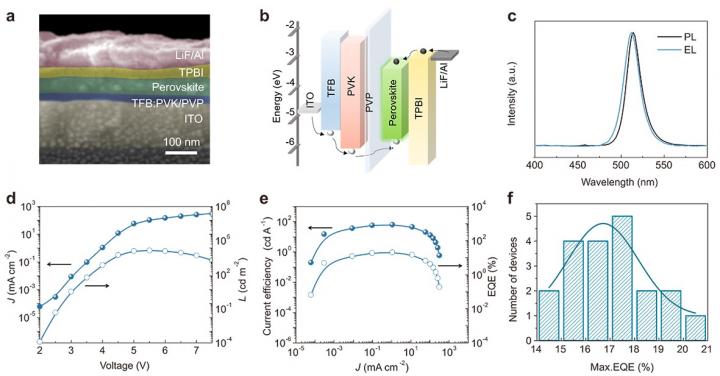Highly efficient LEDs from 2D perovskite films

Scientists use MeS to enhance the electro-luminescence of green-emitting perovskite sheets within a 2D structure
A recent joint-research project co-led by a scientist from City University of Hong Kong (CityU) has now developed a 2D perovskite material for the most efficient LEDs.
Led by Andrey Rogach, chair professor at the Department of Materials Science and Engineering at CityU, and his collaborator Yang Xuyong from Shanghai University, the team has found a kind of dimmer switch: they could turn one light emission from perovskites to a brighter level.
They worked with 2D perovskites (also known as Ruddlesden-Popper perovskites) and succeeded to realise very efficient and bright LEDs, with best-reported performance on both current efficiency and external quantum efficiency for devices based on this kind of perovskites.
Their findings were published in Nature Communications, titled 'Smoothing the energy transfer pathway in quasi-2D perovskite films using methanesulfonate leads to highly efficient light-emitting devices'.
The key to the powerful change lies in the addition of around 10 percent of the simple organic molecule methanesulfonate (MeS).
In this study, the 2D perovskites used by the team have a nanometer level thickness. The MeS reconstructs the structure of the 2D perovskite nanosheets, while at the same time enhancing exciton energy transfer between sheets of different thicknesses. Both of these changes have greatly enhanced the electro-luminescence of the thicker, green-emitting perovskite sheets within the 2D structure.
The MeS is also useful in reducing the number of defects in the 2D perovskite structure. During the process of light production, where radiative recombination took place, part of the excitons required for the process will be "wasted" in the non-radiative recombination which produces no light. MeS reduces the number of uncoordinated Pb2+ cations, the cause for excitons to undergo the non-radiative recombination, making sure more excitons participating in light production.
The results of the research for producing better LEDs has been encouraging. The brightness of 13,400 candela/m2 at a low applied voltage of 5.5 V, and external quantum efficiency of 20.5 percent were recorded. This is close to the maximum that many existing LED technologies can achieve, and has almost doubled the external quantum efficiency level of 10.5 percent reported in their previous study two years ago.
"The achieved high brightness, excellent colour purity, and commercial grade operating efficiency mark 2D perovskites as extremely attractive materials for future commercial LEDs, and potentially also display technology. It's a tangible outcome from both fundamental and applied research into novel nano-scale materials" said Rogach.


































